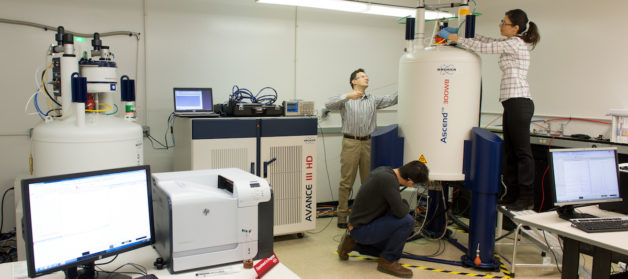December 1, 2017 | News Brief | A team of Department of Energy (DOE) scientists at the Joint Center for Energy Storage Research (JCESR) has discovered the fastest magnesium-ion solid-state conductor, a major step towards making solid-state magnesium-ion batteries that are both energy dense and safe.

Researchers at DOE’s Lawrence Berkeley National Laboratory (Berkeley Lab) and Argonne National Laboratory were working on a magnesium battery, which offers higher energy density than lithium, but were stymied by the dearth of good options for a liquid electrolyte, most of which tend to be corrosive against other parts of the battery. “Magnesium is such a new technology, it doesn’t have any good liquid electrolytes,” said Gerbrand Ceder, a Berkeley Lab Senior Faculty Scientist. “We thought, why not leapfrog and make a solid-state electrolyte?”
The material they came up with, magnesium scandium selenide spinel, has magnesium mobility comparable to solid-state electrolytes for lithium batteries. JCESR, a DOE Innovation Hub, sponsored the study, and the lead authors are Pieremanuele Canepa and Shou-Hang Bo, postdoctoral fellows at Berkeley Lab.
“With the help of a concerted effort bringing together computational materials science methodologies, synthesis, and a variety of characterization techniques, we have identified a new class of solid conductors that can transport magnesium ions at unprecedented speed,” Canepa said.
Collaboration with MIT and Argonne
The research team also included scientists at MIT, who provided computational resources, and Argonne, who provided key experimental confirmation of the magnesium scandium selenide spinel material to document its structure and function.
Co-author Baris Key, a research chemist at Argonne, conducted nuclear magnetic resonance (NMR) spectroscopy experiments. These tests were among the first steps to experimentally prove that magnesium ions could move through the material as rapidly as the theoretical studies had predicted.
“It was crucial to confirm the fast magnesium hopping experimentally. It is not often that the theory and the experiment agree closely with each other,” Key said. “The solid state NMR experiments for this chemistry were very challenging and would not be possible without dedicated resources and a funding source such as JCESR. As we’ve shown in this study, an in-depth understanding of short- and long-range structure and ion dynamics will be the key for magnesium ion battery research.”
NMR is akin to magnetic resonance imaging (MRI), which is routinely used in medical settings, where it shows hydrogen atoms of water in human muscles, nerves, fatty tissue, and other biological substances. But researchers can also tune NMR frequency to detect other elements, including the lithium or magnesium ions that are found in battery materials.
The NMR data from the magnesium scandium selenide material, however, involved material of unknown structure with complex properties, making them challenging to interpret.
Canepa noted the challenges of testing materials that are so new. “Protocols are basically non-existent,” he said. “These findings were only possible by combining a multi-technique approach (solid-state NMR and synchrotron measurements at Argonne) in addition to conventional electrochemical characterization.”
Doing the Impossible
The team plans to do further work to use the conductor in a battery. “This probably has a long way to go before you can make a battery out of it, but it’s the first demonstration you can make solid-state materials with really good magnesium mobility through it,” Ceder said. “Magnesium is thought to move slowly in most solids, so nobody thought this would be possible.”
Additionally, the research identified two related fundamental phenomena that could significantly affect the development of magnesium solid electrolytes in the near future, namely, the role of anti-site defects and the interplay of electronic and magnesium conductivity, both published recently in Chemistry of Materials.
Bo, now an assistant professor at Shanghai Jiao Tong University, said the discovery could have a dramatic effect on the energy landscape. “This work brought together a great team of scientists from various scientific disciplines, and took the first stab at the formidable challenge of building a solid-state magnesium battery,” he said. “Although currently in its infancy, this emerging technology may have a transformative impact on energy storage in the near future.”
Gopalakrishnan Sai Gautam, another co-author who was an affiliate at Berkeley Lab and is now at Princeton, said the team approach made possible by a DOE hub such as JCESR was critical. “The work shows the importance of using a variety of theoretical and experimental techniques in a highly collaborative environment to make important fundamental discoveries,” he said.
Ceder was excited at the prospects for the finding but cautioned that work remains to be done. “There are enormous efforts in industry to make a solid-state battery. It’s the holy grail because you would have the ultimate safe battery. But we still have work to do. This material shows a small amount of electron leakage, which has to be removed before it can be used in a battery.”
Funding for the project was provided by the DOE Office of Science through the Joint Center for Energy Storage Research, a Department of Energy Innovation Hub. The Advanced Photon Source, a DOE Office of Science User Facility at Argonne, added vital data to the study regarding the structure of the solid conductor. The National Energy Research Scientific Computing Center (NERSC), a DOE Office of Science User Facility at Berkeley Lab, provided computing resources. Other co-authors on the paper are Juchaun Li of Berkeley Lab, William Richards and Yan Wang of MIT, and Tan Shi and Yaosen Tian of UC Berkeley







